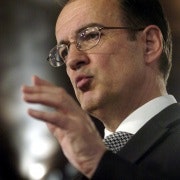Google hints at the NBN's future
With the Australian election date now slated for September, the NBN debate is set to kick into overdrive.
We've moved beyond asking whether or not we should have an NBN; all parties have confirmed that the network will stay regardless of who gets into power.
So now that we are stuck with some form of high speed broadband network, many are probably asking whether fibre technology will make any difference to our industries and our lives.
Such a debate is already happening in the US. A recent report by Akamai cited the average US download speed to be at a slow 5 Mbps and it's not set to change anytime soon given that the majority of the country's telcos don't see a business case for faster internet.
But where the US telcos see loss, Google sees opportunity. It's rolling out its own high speed network, and the success stories emerging from project may just vindicate Australia's NBN ambitions.
What is Google Fiber?
Google announced it ambitious NBN-like project two years ago. The internet giant intends to cover all of Kanas City in fibre and provide high-speed internet access for the city's population of 2.1 million.
Google will do this by rolling out fibre enabled by active Ethernet technology to homes and businesses in Kansas City and its surrounding regions. It's set to provide the area with an internet connection that will reach download and upload speeds of up to 1Gbps. In addition, residents who don't want to sign up for Google's deluxe service can attain a free, but drastically slower 5 Mbps download speed alternative.
Unlike the NBN, residents need to opt into the project and pay a fee for the fibre to be installed. Kansas City neighbourhoods had to achieve between 5-25 per cent of homes to sign on for a Google Fiber service for the neighbourhood to qualify for the rollout.
Despite the installation fee, 180 out of the eligible 202 neighbourhoods signed on for Google Fiber before the registration deadline.
With the rollout well underway, evidence is emerging that the Google Fiber network rollout is transforming Kansas City into a tech boomtown.
According to The Washington Post, the project is having a positive effect on the start-up scene in Kansas City. Capitalising on this, last month the city's mayor Sly James launched a program to provide cheap office rental, free Wi-Fi, a data storage and reduced taxes for tech companies that relocate to Kansas City.
Synthia Payne is one US entrepreneur who jumped the border from Denver to Kansas to draw benefit from Google's fibre experiment. Her idea, CyberJammer, aims to let musicians located in different parts of the world jam together by syncing what they play in real-time. It's a bold ambition and it's only made possible by a high speed fibre connection. And there would be many other start-ups that would be moving to Kansas City for the same reason.
It's not about comparing, it's about faster internet
Make no mistake; there are a multitude of differences between Google's Fiber project and the NBN.
For instance, Google is giving everyone on its service access to their own direct fibre connection to an aggregation point. In contrast, NBN Co will share one fibre connection from the aggregation point between a multitude of properties to reduce costs.
As a result, Google's network will be faster and more expensive per unit of population than the NBN.
And this is all because the NBN is a government-funded national rollout and Google Fiber is a privately funded project focused on one city initially.
Such differences make it difficult to directly compare Google's Fiber to the NBN. But the moral of this story isn't about comparing networks; it's about the impact of faster internet access.
As time rolls on and the NBN is rolled out similar stories to what we're currently hearing about with Google Fiber will start to emerge in Australia. We have the potential to become a hub for technology and innovation within our region.
Who knows, perhaps the Australian NBN example might convince the US that rolling out high speed fibre isn't such a bad idea after all.
Mark Gregory is a Senior Lecturer in Electrical and Computer Engineering at RMIT University













